Prehistory and Early History
This chapter covers topics from the origins of speech, design, and story telling prior to recorded history to the first human settlements that led to the earliest civilizations and the invention of writing. It includes illustrations of prehistoric artifacts and a series of maps on human migration, cave art and the locations and dates of the first largescale civilizations along major rivers in different parts of the world.
TOPICS
• Prehistory: Speech, Design, Counting, Story telling
• Prehistoric cave art
• Modern human migration
• The First Civilizations: First settlements
• First cities and states: Mesopotamia, Egypt, Greece, India, China
• First cities and writing
• Venus of Berekhat Ram illustration
• Lebombo bone illustration
• Prehistoric cave art map
• Modern human migration map
• First civilizations map
• Fertile Crescent map
• First cities and writing timeline
• Altamira cave painting
• Lascaux cave painting
Although most of modern humans’ existence has preceded recorded history, we have evidence of or can infer several innovations from that time period. First there was the development of speech, and then the earliest purposeful designs, including sculpted objects and paintings on cave walls, which might be the earliest records of story telling. Also, there were technological advances such as metal casting and ceramics, and the invention of counting systems.
Human evolution
World History Encyclopedia: Paleolithic: ancient.eu/Paleolithic
Exploratorium: annex.exploratorium.edu/evidence/
Smithsonian National Museum of National History: humanorigins.si.edu/
International Business Times: Oldest human remains found outside Africa
National Geographic: Oldest human remains found outside Africa
Nature Journal of Science: Oldest homo sapiens fossil
New Scientist: Timeline: Human Evolution
proof-of-evolution.com: Human Evolution Timeline
Science Alert: Did Homo sapiens kill off other humans?
The Atlantic: How humans tamed themselves
Speech
Sapiens: A brief History of Humankind. Yuval Noah Harari, HarperCollins 2011.
amazon.com/Sapiens-Humankind-Yuval-Noah-Harari
A Sneaky Theory of Where Language Came From. Stanford University biologist Oren Kolodny and Cornell University professor of psychology Shimon Edelman. The Atlantic, June 10, 2018
How Could Language Have Evolved?. Johan J. Bolhuis, Ian Tattersall, Noam Chomsky, and Robert C. Berwick. PLOS Biology, August 26, 2014
A ‘Mic Drop’ on a Theory of Language Evolution. Louis-Jean Boë1, Thomas R. Sawallis, Joël Fagot, Pierre Badin, Guillaume Barbier, Guillaume Captier, Lucie Ménard, Jean-Louis Heim and Jean-Luc Schwartz. The Atlantic, December 12, 2019
Why Are so Many Languages Spoken in Some Places and so Few in Others? Marco Túlio Pacheco Coelho and Michael Gavin, The Conversation, Aug. 15, 2019
Conserved alarm calls but rapid auditory learning in monkey responses to novel flying objects. Franziska Wegdell, Kurt Hammerschmidt and Julia Fischer. Nature Journal of Science, May 27, 2019.
Monkey experiments offer clues on origin of language. Marlowe Hood. Phys.org, May 27, 2019.
Design
Homo erectus made world's oldest doodle 500,000 years ago. Ewen Callaway, Nature Journal of Science, Dec. 3, 2014.
540,000-Year-Old Shell Carvings May Be Human Ancestor's Oldest Art. Laura Geggel, LiveScience.com, Dec. 3, 2014.
A Journey to the Oldest Cave Paintings in the World. Jo Marchant, Smithsonian Magazine, Jan./Feb. 2016.
U-Th dating of carbonate crusts reveals Neandertal origin of Iberian cave art. 14 authors, Science Magazine, Feb. 23, 2018.
Prehistory - Painting Techniques. Pigments Through the Ages exhibit, Michael Douma, curator, 2008.
Oldest cave art found in Sulawesi. 10 authors, Science Advances Magazine, Jan. 13, 2021.
Neanderthals
The Neanderthal renaissance. Rebecca Wragg Sykes, Aeon, March 13, 2019.
A Skull Bone Discovered in Greece May Alter the Story of Human Prehistory. Carl Zimmer, The New York Times, July 10, 2019.
Symbolic use of marine shells and mineral pigments by Iberian Neandertals 115,000 years ago. Dirk L. Hoffmann, Diego E. Angelucci, Valentín Villaverde, Josefina Zapata, João Zilhão, Science Advances, Feb. 22, 2018.
Figurative art
Earliest hunting scene in prehistoric art. 14 authors, Nature journal of science, Dec. 11, 2019.
The origins of ceramic technology at dolni vecaronstonice, czechoslovakia. P B Vandiver, O Soffer, B Klima, J Svoboda, National Center for Biotechnology Information, Nov. 24, 1989.
Early Pottery at 20,000 Years Ago in Xianrendong Cave, China. Xiaohong Wu, Chi Zhang, Paul Goldberg, David Cohen, Yan Pan, Trina Arpin, Ofer Bar-Yosef, Science, June 29, 2012.
Venus of Berekhat Ram (230-700,000 BCE). Encyclopedia of Stone Age Art, Visual-arts-cork.com.
Venus of Tan-Tan (200-500,000 BCE). Encyclopedia of Stone Age Art, Visual-arts-cork.com.
Counting
Animals that can count. Jason G Goldman, BBC, Nov. 27, 2012.
History of ancient numeral systems. Wikipedia.
Animals that count: How numeracy evolved. Ewen Callaway, New Scientist, June 17, 2009.
Migration
Ancient stone tools hint at settlers’ epic trek to North America. Ewen Callaway, Nature, Aug. 29, 2019.
In Neanderthals’ DNA, Ancient Humans May Have Left Genetic Mark. Carl Zimmer, The New York Times, Feb. 17, 2016.
The Great Human Migration. Guy Gugliotta, Smithsonian Magazine, July 2008.
The Seeds of Civilization. Michael Balter, Smithsonian Magazine, May 2005.
First cities
Emergence and Change in Early Urban Societies. Edited by Linda Manzanilla, Universidad Nacional Autónoma de México, Springer-Verlag US 1997
When did humans settle down? The house mouse may have the answer. Michael Price, sciencemag.org, March 27, 2017.
Gobekli Tepe: The World’s First Temple? Andrew Curry, Smithsonian Magazine, Nov. 2008.
The Seeds of Civilization. Michael Balter, Smithsonian Magazine, May 2005.
Mesopotamia
The Babylonians—An Introduction. Gwendolyn Leick, Routledge 2002
Sumerians. Joshua J. Mark, Ancient.eu, Oct. 9, 2019.
Ancient Literacy. William V. Harris, British Museum, 1991.
Egypt
Ancient Egypt History.com Editors
India
Brahmi Script Cristian Violatti, ancient.eu, Nov. 14, 2016.
Indus Script Cristian Violatti, ancient.eu, June 5, 2016.
Ancient civilization: Cracking the Indus script. Andrew Robinson, Nature journal of science, Oct. 20, 2015.
China
Chinese Writing Emily Mark, ancient.eu, April 7, 2016.
The Yellow River's Role in China's History. Kallie Szczepanski, Thoughtco, July 28, 2019.
Money
Coinage. Jan van der Crabben, ancient.eu, April 28, 2011.
The history of money from barter to bitcoin. Rebecca Burn Callender, The Telegraph, Oct. 19, 2014.
NOTE: Weblinks were current and active at the time of the last update to the site, but may have since become unavailable or outdated. If you encounter a dead link, please notify me at phil.loubere@mtsu.edu. Thanks.
Last update: April 2021
Content related to this chapter’s topics will be periodically posted here.
Human evolution
New discoveries continue to enlighten our understanding of the hominid lineage that led to modern humans, and how our antecessors lived. Recent evidence has changed the consensus on the culture of Neanderthals and their interactions with modern humans, for example, suggesting that they may have done cave painting and engaged in other creative activities. Genetic studies have also demonstrated that all modern humans are descended from a single exodus from Africa about 75,000 years ago. However, Neanderthal genes have been found in a significant portion of people alive today.
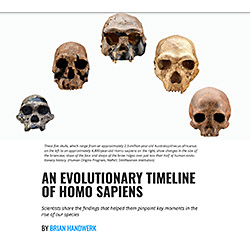
An Evolutionary Timeline of Homo sapiens. Brian Handwerk, Smithsonian magazine, Feb. 2, 2021.
This Smithsonian article explains how scientists use prehistoric bones and stone tools to understand how our ancestors evolved.

First 'Homo' species left Africa with ape-like brains. Laura Gegge, livescience.com, Apr. 8, 2021.
This article discusses how new imaging techniques helped scientists better understand the evolutionary progression in our ancestors’ brain size and complexity.
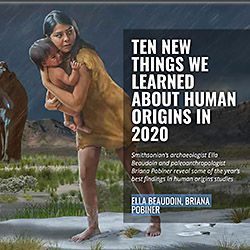
Ten New Things We Learned About Human Origins in 2020. Ella Beaudoin, Briana Pobiner, Smithsonian magazine, Dec. 29, 2020.
This article lists a number of new discoveries that further informed us on where and how humans originated.
Speech
The origin of speech, particularly complex speech involving sentence structure, remains the subject of widely varied speculation.
There are anatomical and cognitive requirements for speech. In order to be able to make the range of sounds needed, it was necessary for human antecessors to develop a larynx, or voicebox, with vocal chords and the flexibility to make a range of sounds. The earliest common ancestor of modern humans and other primates that had this anatomical adaptation existed 27 million years ago. Based on this, some hypothesize that speech ability is likely millions of years old.
The other aspect is cognitive, the mental capacity to associate speech sounds with concepts, and to establish a communal language within a social group. Hypotheses based on this aspect place speech, or at least complex speech, much more recently, as little as 70,000 years ago.
There are several proposals about how complex speech came about. Yuval Noah Harari hypothesizes that complex language evolved as a result of gossip. Oren Kolodny and Shimon Edelman suggest that it came about with the appearance of Acheulean stone tool technology 1.76 million years ago. Linguist Noam Chomsky and computer scientist Robert Berwick suggest that a genetic variation within the last hundred thousand years gave relatively sudden rise to complex speech.
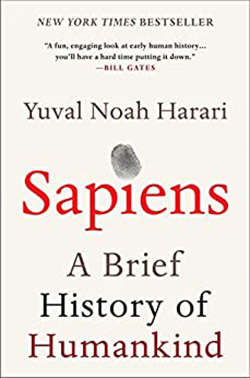
Sapiens: A Brief History of Mankind. Yuval Noah Harari, HarperCollins 2011.
In this book, Dr. Harari discusses human cognitive development beginning around 70 thousand years ago, including hypotheses about the evolution of human speech.
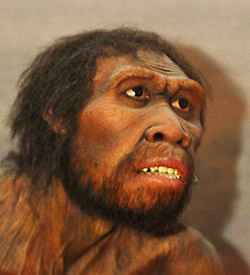
A Sneaky Theory of Where Language Came From. Ben James, The Atlantic, June 10, 2018.
Oren Kolodny, a biologist at Stanford University, and his co-author, Shimon Edelman, a professor of psychology at Cornell University, hypothesize that the evolution of the cognitive ability to make complex stone tools, requiring multiple steps that must be done in a correct sequence, also made complex speech possible in early humans more than 1.5 million years ago.

Why Only Us: Language and Evolution. Robert C. Berwick and Noam Chomsky, MIT Press, May 12, 2017.
In this book, the authors discuss their hypotheses on the evolution of language.

Talking parrots and the origins of human intelligence. Harvard University, Dec. 5, 2013.
This African Gray Parrot Is the First Animal To Ever Ask an Existential Question. Arnesia Young, mymodernmet.com, Dec. 29, 2020.
A parrot that developed remarkable speech abilities raises interesting questions about the uniqueness of human speech.
Design
Design, in the production of both tools and artistic objects, does require a basic level of technology, generally requiring some tools and/or media such as paint. The earliest design discovered to date is half a million years old, a geometric pattern carved into a shell found in Indonesia. Small sculpted objects have been found that are possibly nearly as old. These would have been made by early humans, before the emergence of Homo sapiens about 300,000 years ago, and some found in places well before modern humans migrated there.
Cave paintings are the clearest evidence of attempts at story telling. The oldest of these also precede the appearance of Homo sapiens in the parts of the world where they have been discovered, evidence that Neanderthals and possibly other early humans including H heidelbergensis were the creators. The oldest paintings yet discovered are nearly 65,000 years old, but most are between 30,000 and 15,000 years old.
Cave painting is also hypothesized to be the first step in the development of written language.
Homo erectus made world's oldest doodle 500,000 years ago. Ewen Callaway, Nature Journal of Science, Dec. 3, 2014.
U-Th dating of carbonate crusts reveals Neandertal origin of Iberian cave art. 14 authors, Science Magazine, Feb. 23, 2018.
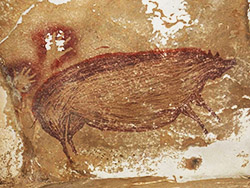
Oldest Known Animal Art. Brian Handwerk, Smithsonian magazine, Jan. 2021.
Indonesian cave paintings of pigs might be 45,500 years old, making them the oldest representational cave art to date.
First cities
Cities appeared in the places where humans first settled into permanent habitation, the most notable of which were along the great rivers of the World—The Tigris and Euphrates, the Nile, the Indus, the Yellow, but also in places such as Crete and mainland Greece, and in present-day Mexico in the MesoAmericas. It was in these cities that writing most likely first appeared, a necessity for political order and for trade, two human inventions that also came about with permanent settlements.
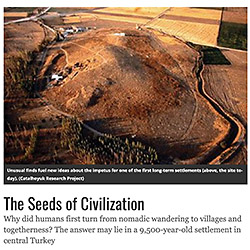
The Seeds of Civilization. Michael Balter, Smithsonian magazine, May 2005.
Examination of a 9,500-year-old settlement in central Turkey gives some clues as to why humans started permanent settlements.
Last update: June 2023


